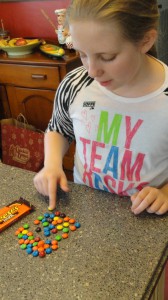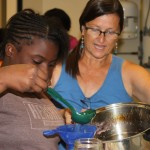by Whitney Cherry | Jul 1, 2014
Article by guest blogger, Georgene Bender (South Central Regional Specialized 4-H Agent)

Photography by David Perkiewcz,, The Cleveland Plain Dealer
Photography is a popular 4-H project and this time of year, it is fun to experiment taking pictures of fireworks and sparklers. With helpful tips you will be amazed at what you can do. Let’s review some basics. The word “photography” means drawing with light….so the key is the amount of light needed for these unique shots. Basically there are two camera types a) point & shoot and b) Digital Single-lens reflex. Each camera type has various features. It is good to familiarize yourself with them in the Menu or camera manual. What? You don’t have that book anymore. No problem – search for it online.
Focus on Infinity- Set your focus to just less than infinity (or choose a landscape setting if you can’t manually adjust focus) and use an aperture of f/8 t- f/16.
Equipment- Be sure to take a small flashlight to adjust your settings in the night and a sturdy tripod – this is the best to reduce movement and blurred photos. Another great tool for the SDLR is the cable release cord that you can control the shutter’s button or the digital remote. Digital cameras will have a setting.
Bust Shooting- Also known as ‘continuous drive’ allows you to shoot multiple shots automatically. On a DSLR go to your menu and select Self-timer and you will see two options inside. A) Self-timer delay allows you to set time after how many seconds camera should take a shot and available values are 2s, 5s, 10s, and 20s. B) Number of shots you want to take in self-timer mode. You can choose between 1 and 9 shots.
Five Top Tips:
- Observe the wind direction from where you are. Pick a location upwind so that your photos do not turn out hazy.
- Pack extra batteries and memory cards- long exposures drain battery life, and you will need to shoot lots of pictures to get a few great shots.
- Watch for the fireworks as they travel and push and hold the release button. (This will take time to practice – and also the bust shooting will help for better capture)
- Learn more online. A couple of good sources include the Walt Disney World (WDW) Photography series. There are YouTube videos by Cory Disbrow from WDW Photography.com http://youtu.be/yZh_ADUsgrY and http://wdwphotography.com.
- Practice playing with light before the fireworks by having friends ‘air write’ their name with the flashlight or sparklers. You, with your trusty tripod and camera settings shoot pictures. You will be amazed at what you get.
This chart below gives you the areas of each camera type to prepare before shooting.
|
SETTINGSMenu screen or, Bulb |
SHUTTERControls the open/close of light into camera |
ISOSensitivity of the light |
FLASHArtificial light |
APERTUREControls amount of light |
| Point and Shoot |
Manual(Check your manual as compact cameras have this as a menu optionLook for information on a delay release timer. |
Keep open for 10– 30 seconds; find your ‘night setting’ might be a half moon with starsThere is no B setting on Compact Cameras |
Lowest it will go |
OFF |
N/A |
| DSLR |
M = MANUALB= BULBTurn on noise reduction
Delay release setting |
On B setting, you can hold the camera button for as long as you want10 – 60 sec then went you release the button the shutter will close out the light. |
100 or lower |
OFF |
Changing the aperture is changing the f-stop.Set between f2.8 and f8
The lower the f-stop the more light |

Photo by Jill Wellington
Take lots of pictures this weekend– and please SHARE your best shot on our blog, Facebook, or Twitter! To learn more about the 4-H Photography Project and Contests, visit http://florida4h.org/programsandevents_/photo/photo-contest-resources/. If you have a passion for photography, consider serving as a 4-H photography project leader or becoming a sponsor of your local 4-H photography program. For more information, contact Heather Kent at hckent@ufl.edu.
Credits to:
Fleenor, S., Asdtroth, K. and Peters, C. 2010. “Catch the Spark” University of Arizona Extension 4-H Youth Development.
“How to Take Multiple Shots in Self-Timer Mode.” http://www.dailyphotographytips.net/question-answer/how-to-take-multiple-shots-in-self-timer-mode/
Harnocz, A. July 1, 2014 “How to Photography Fireworks” The Cleveland Plain Dealer. http://www.cleveland.com/interact/2014/07/how_to_photograph_fireworks_5.html
by Monica Brinkley | Mar 10, 2014
 With the passing of Valentine’s Day I hope that you have been able to enjoy a taste of chocolate. You have probably heard by now that chocolate is good for you. Do you believe it? This is a fact that is backed by research. Still most of us can’t help but be concerned about how something so sweet might adversely impact our health. Chocolate lovers, even those at risk for developing type II diabetes or hypertension, many now have a legitimate reason to indulge in this culinary pleasure.
With the passing of Valentine’s Day I hope that you have been able to enjoy a taste of chocolate. You have probably heard by now that chocolate is good for you. Do you believe it? This is a fact that is backed by research. Still most of us can’t help but be concerned about how something so sweet might adversely impact our health. Chocolate lovers, even those at risk for developing type II diabetes or hypertension, many now have a legitimate reason to indulge in this culinary pleasure.
A study reported in the American Journal of Clinical Nutrition tested the effects of dark and while chocolate on healthy adults to determine whether either type played a role in blood pressure and insulin sensitivity. They concluded that dark chocolate can indeed help reduce blood pressure and insulin resistance. White chocolate did not provide these health benefits. The effects of dark chocolate are due to flavanols, antioxidant compounds also found in many fruits and vegetables that have been shown to lower risk of heart disease. Flavonols make dark chocolate in moderation a great solution to satisfy your sweet tooth!
Keep in mind that although dark chocolate has health benefits, most chocolate bars are high in saturated fat, so moderation is key. Also, eating dark chocolate cannot substitute for everyday healthy food choices. Nor can chocolate replace regular exercise or medications that have been prescribed by your physician. Still, it’s nice to know you can indulge in your chocolate cravings every so often without feeling guilty about it.
The Project, Land and People, Resources for Learning that is available through the Florida Ag in the Classroom program has a great lesson, Loco for Cocoa that gives the background of chocolate as well as various activities for youth in grades 6-12.
Acres of Adventures Afterschool Curriculum produced by National 4-H has a M&M Mystery Challenge as well as the following link has M&M Math Worksheets: http://www.4-h.org/resource-library/curriculum/4-h-afterschool-agriculture/acres-of-adventures-1/#BookMark2
Ag in the Classroom, Illinois Farm Bureau has an educational brochure, Candy – Culture and Creativity that I found on the National 4H website under the Acres of Adventures page.
The website Science Kids at http://www.sciencekids.co.nz/videos/chemistry/chocolate.html has a video showing the Science of Chocolate. At the top of the page there is a link to experiments, one of which is Melting Chocolate, which can be done with youth.
In researching activities centered around chocolate I found quite a few team building games that relate to chocolate.
Explore with your 4-H members all the yummy things about chocolate, I think you will find that you enjoy the topic as much as they will.
Source: Dark Chocolate Benefits by Sherri Gampel and Linda B. Bobroff, UF/IFAS document FAR8057.
by Whitney Cherry | Dec 6, 2013

4-H Volunteers strive to provide safe and secure learning environments.
From time to time new laws regarding youth protection are considered by federal and/or state lawmakers. As these new laws and regulations are passed their effects are wide-felt, and often they reach into the 4-H program. One such federal regulation on youth protection was recently passed, and while the new protection that it affords our youth is much welcomed, it does mean that 4-H volunteers will be seeing some changes in their county’s volunteer screening procedures.
What are the major changes?
- All club leaders must be “435 Level 2” screened. This means you will be fingerprinted.
- All volunteers who work with youth 10 hours or more in a month, even if they are not club leaders, will be “435 Level 2 screened. This means you will be fingerprinted.
- All camp counselors will be “435 Level 2” screened.
- All volunteers working directly with youth will be “Level 1” screened regardless of the number of hours spent with youth. This means you will be background checked, but may not fingerprinted.
What can new and existing volunteers expect?
- Existing volunteers may have completed some of these steps under our former system for volunteer screening. They will be asked to complete the steps that are new. New potential volunteers will need to complete each of the following steps in order before they should work directly with youth.
- 435 Level 2 screening:
- Register in 4HOnline (http://florida.4honline.com)
- Interview with your 4-H agent (Your 4-H agent will also obtain at least two letters of reference.)
- Complete the online youth protection training (YCS800)
- Return a notarized Affidavit of Good Moral Character to your 4-H agent
- Schedule livescan finger printing (Your 4-H agent will help you with this.)
- Be finger printed for 435 Level 2 screening
- Receive a letter of appointment from your 4-H agent
- Level 1 screening
- Register in 4HOnline (http://florida.4honline.com)
- Interview with your 4-H agent (Your 4-H agent will also obtain at least two letters of reference.)
- Complete the online youth protection training (YCS800)
- Be background screened (Your 4-H agent will complete the screening.)
- Receive a letter of appointment from your 4-H agent
- The new policy also places an emphasis on accurate and timely record keeping, so your agent may require additional training on this subject.
This policy is new for agents and volunteers alike, so please be patient with your local extension office as they try to work as quickly and efficiently as possible to get all of their volunteer screenings up-to-date.
A copy of the new UF/IFAS Youth Protection Policy can be found at: http://florida4h.org/volunteers/risk_management/files/Youth_Protection.pdf*
*The official policy takes precedence over any discrepancies which may be found in this article.
by pmdavis | Nov 25, 2013
 Thanksgiving is a time of family traditions, reflection and thankfulness! Remember to include children in the planning and preparation. In 4-H, we stress learn by doing and want to encourage you to consider that motto. Children love being included that inspires their creativity, imagination and sense of belonging. Being involved teaches life skills, such as measuring, meal preparation, teamwork, design and relationship building.
Thanksgiving is a time of family traditions, reflection and thankfulness! Remember to include children in the planning and preparation. In 4-H, we stress learn by doing and want to encourage you to consider that motto. Children love being included that inspires their creativity, imagination and sense of belonging. Being involved teaches life skills, such as measuring, meal preparation, teamwork, design and relationship building.
Some ways to involve children are very simple! Have them help shop or find bargains with a Thanksgiving Scavenger Hunt. Give each child a list of grocery products to find. They will have fun locating items at the store or finding the best buys in advertisements. Older kids can clip coupons.
Make simple inexpensive decorations. Create turkey hand or leaf wall hangings, wreaths, a tree of thanks, clay or play dough holiday ornaments, centerpieces, placemats, name cards, napkin rings. Napkin rings can be made out of cut paper towel rolls or construction paper glued in a circle and decorated with artwork, fabric, leaves or even feathers. Guests will admire these items while enjoying the meal.
To help the day go smoothly, consider your needs and home size. For example, if you have a small kitchen let them help you prepare items ahead of time for the meal i.e cranberry salad. Consider having older youth select a recipe to be the lead chef. Doing a trial run prior to the holiday meal. Kids can easily help: wash fruits and vegetables, snap green beans, crack eggs, stir cake batter, roll out pie crusts, mash potatoes, sprinkling marshmallows or put relish items on a tray.
Let kids set the table. Make the task simple by using printable table-setting cheat sheet, showing where items should be placed. Have kids count out the number of place-mats, name cards and napkin rings needed.
Other traditions to consider include:
- 1. Create a turkey of thanks. Have children cut paper feathers and place them at each place setting. When everyone sits down to eat, have them write one thing they are thankful for. Create a paper turkey centerpiece by passing a paper bag and glue stick letting each person glue on their feather telling why they are thankful.
- 2. Make a family trivia game. Have children ask each person to write down trivia questions about events that happened during the year, or family history. Collect the questions and give out small prizes for each correct answer.
- 3. Play the A to Z family gratitude game. Have everyone sit together and each person says what they’re grateful for, according the letter of the alphabet the player is up to.
- 4. Read a book about Thanksgiving to help children learn the meaning of Thanksgiving.
- 5. Help someone less fortunate or in poor health by serving meals, raking leaves, taking a plate of food.
Sounds simple, and in all reality it is. Adults give guidance to children helping them identify and feel good the positive things in their lives. The trick is to relax, plan and enjoy the holiday together. One web page that gives lots ideas for holiday decorations the family can do together http://aboutfamilycrafts.com/30-turkey-crafts-for-kids/. All Extension programs are open to all persons regardless of race, color, age, sex, handicap or national origin.
by Melanie Taylor | Nov 22, 2013
As the autumn temperatures continue to fall, and we fill our days and evenings with more time outside, many of us yearn to enjoy the natural beauties of the environment without the humidity, extreme heat, and summer insects. During the activity portion of each 4-H Club meeting is a great time to explore and create using the natural resources around us. The purpose of these nature projects is to develop an appreciation for our environment. Conservation can only truly take place once we have recognized the natural beauty and wonder that surrounds us. These projects are generally easy to do, and kids can work on them together if they wish. And, there are more challenging projects for the older 4-H youth.

Gulf County adult 4-H Club leader assists a 4-Her on the finishing
touches of her grapevine wreath.
The Gulf County 4-H Craft Club members recently made their own grapevine wreaths and decorated them in their own creative ways.
Materials:
- vine
- pruners
- ribbon and a variety of decorating supplies (pinecones, twigs, leaves, glitter, character cut-outs, floral decorations, miniature birds, etc.)
- hot glue and glue gun
- pipe cleaners (to make a hook for hanging)
Directions:
1. Be sure to begin by finding a large location that can get dirty. The vines drop lots of debris. Find an abundance of firm, but bendable grape vines, gathering and untangling the vine pieces. When they have been tamed into a bundle (thickness is based on individual preference) that is manageable, form the vine into a circular shape on a large surface. Using a few thick strands of vine, begin to wind around the bundle, tucking the end of the vine in. (Note: if natural vines are not available, premade wreaths may be purchased at any craft store at a minimal cost.)
2. Continue to wind and secure the entire wreath. When the end meets the beginning, knit the vine ends together and continue to wind the outer vines to secure, overlapping the starting point. Tuck in any loose ends.
3. Set the wreath somewhere to dry and take shape. Preferably in a warm, sunny location. They will dry much faster this way. (If the kids will be making their own vine wreaths, and not using a pre-purchased one from a craft store, the wreath will need to be made days ahead of the decorating to give it time to dry properly.)
4. Now, it’s time to decorate. Let the kids be imaginative and create their own unique wreath to match their likes and personality. They can experiment by placing the items in different locations on the wreath. Once their decorating decisions are made use the hot glue to secure the items, ribbons, etc.
5. Do not forget to form a loop with a short piece of pipe cleaner to make a hook on the back of the wreath to hang it from.

4-H Club members showcase their grapevine wreaths
Now, the wreaths can be taken home and enjoyed by all. Be sure to remember that time spent in nature is calming and refreshing to the human mind. So, as the weather becomes more tolerable here in Florida be sure to take time for yourself and to show youth the importance of natural exploration and creativity.
by jgl1 | Nov 8, 2013
John G. Lilly
jgl@ufl.edu
Jefferson County Extension Director/4-H Agent
Young people in 4-H are committed to improving their communities. Dr. Richard Lerner, and the team at the Institute for Applied Research in Youth Development at Tufts University highlights a notable trend. 4-H youth are three times more likely to actively contribute to their communities when compared with youth who do not participate in 4-H. (more…)







